LIN2.1.book
Specification Package
Revision history
Table of contents
1.1 LIN
1.1.1 Scope
1.1.2 Features and possibilities
1.1.3 Work flow concept
1.1.4 Node concept
1.1.5 Concept of operation
1.1.5.1 Master and slave
1.1.5.2 Frames
1.1.5.3 Data transport
1.1.5.4 Schedule table
1.1.6 Document overview
1.1.7 History and background
1.1.7.1 Compatibility with LIN 1.3
1.1.7.2 Compatibility with LIN 2.0
1.1.7.3 Changes between LIN 1.3 and LIN 2.0
1.1.7.4 Changes between LIN 2.0 and LIN 2.1
1.1.8 References
1.2 LIN Glossary
Protocol Specification
2.1 Introduction
2.2 Signal Management
2.2.1 Signal types
2.2.2 Signal consistency
2.2.3 Signal packing
2.2.4 Signal reception and transmission
2.3 Frame Transfer
2.3.1 Frame structure
2.3.1.1 Break field
2.3.1.2 Sync byte field
2.3.1.3 Protected identifier field
2.3.1.4 Data
2.3.1.5 Checksum
2.3.2 Frame length
2.3.3 Frame types
2.3.3.1 Unconditional frame
2.3.3.2 Event triggered frame
2.3.3.3 Sporadic frame
2.3.3.4 Diagnostic frames
2.3.3.5 Reserved frames
2.4 Schedule tables
2.4.1 Time definitions
2.4.2 frame Slot
2.4.3 Schedule table handling
2.5 Task Behavior Model
2.5.1 Master task state machine
2.5.2 Slave task state machine
2.5.2.1 Break/sync field sequence detector
2.5.2.2 Frame processor
2.6 Network Management
2.6.1 slave communication state diagram
2.6.2 Wake up
2.6.3 Go to sleep
2.7 Status Management
2.7.1 Concept
2.7.2 Event triggered frames
2.7.3 Reporting to the cluster
2.7.4 Reporting within own node
2.8 Appendices
2.8.1 Table of numerical properties
2.8.2 Table of valid frame identifiers
2.8.3 Example of checksum calculation
2.8.4 Syntax and mathematical symbols used in this standard
Transport Layer Specification
3.1 Introduction
3.2 Transport layer
3.2.1 PDU structure
3.2.1.1 Overview
3.2.1.2 NAD
3.2.1.3 PCI
3.2.1.4 LEN
3.2.1.5 SID
3.2.1.6 D1 to D6
3.2.2 Communication
3.2.2.1 Single Frame Transmission
3.2.2.2 Multiple Frame Transmission
3.2.3 Error Handling
3.2.4 Defined requests
3.2.5 timing constraints
Node configuration and Identification Specification
4.1 Introduction
4.2 Node configuration and identification
4.2.1 LIN product identification
4.2.1.1 Wildcards
4.2.2 Slave Node model
4.2.2.1 Initial NAD
4.2.3 PDU structure
4.2.3.1 Overview
4.2.3.2 NAD
4.2.3.3 PCI
4.2.3.4 SID
4.2.3.5 RSID
4.2.3.6 D1 to D5
4.2.4 Node configuration and identification
4.2.5 Node configuration services
4.2.5.1 Assign NAD
4.2.5.2 Conditional change NAD
4.2.5.3 Data dump
4.2.5.4 Save Configuration
4.2.5.5 Assign frame ID range
4.2.6 Identification
4.2.6.1 Read by identifier
Diagnostic specification
5.1 Introduction
5.1.1 using the transport layer
5.1.2 LIN master
5.1.3 slave nodes
5.2 Diagnostic classes
5.2.1 Diagnostic Class I
5.2.1.1 Transport protocol
5.2.1.2 Diagnostic services
5.2.2 Diagnostic Class II
5.2.2.1 Transport protocol
5.2.2.2 Diagnostic services
5.2.3 Diagnostic Class III
5.2.3.1 Addressing
5.2.3.2 Transport protocol
5.2.3.3 Diagnostic services
5.2.4 Summary of slave node classes
5.2.5 Master node requirements
5.2.5.1 Transport protocol
5.2.5.2 Fault management, sensor reading, I/O control
5.2.6 User defined diagnostics
5.3 Requirements for Signal based Diagnostics
5.4 Transport Protocol handling in LIN- master
5.4.1 Diagnostic master request schedule
5.4.2 Diagnostic slave response schedule
5.4.3 Diagnostic schedule execution
5.4.3.1 Diagnostics Interleaved Mode
5.4.3.2 Diagnostics Only Mode
5.4.4 Transmission handler requirements
5.4.4.1 Master node transmission handler
5.5 Slave node transmission handler
5.6 Slave diagnostic timing requirements
Physical Layer Specification
6.1 Introduction
6.2 Physical Layer Compatibility
6.3 Bit rate Tolerance
6.4 Timing Requirements
6.4.1 Bit Timing Requirements
6.4.2 Synchronization Procedure
6.4.3 Bit Sample Timing
6.5 Line Driver/Receiver
6.5.1 General Configuration
6.5.2 Definition of Supply Voltages for the Physical Interface
6.5.3 Signal Specification
6.5.4 Electrical DC parameters
6.5.4.1 Electrical AC Parameters
6.5.5 Line Characteristics
6.5.6 Performance in non-operation supply voltage range
6.5.7 Performance during fault modes
6.5.7.1 Loss of supply voltage connection or ground connection
6.5.7.2 Bus wiring short to battery or ground
6.5.8 ESD/EMI compliance
Application Program Interface Specification
7.1 Introduction
7.1.0.1 LIN cluster generation
7.1.1 Concept of operation
7.1.1.1 LIN core API
7.1.1.2 LIN node configuration and identification API
7.1.1.3 LIN transport layer API
7.2 Core API
7.2.1 Driver and cluster management
7.2.1.1 l_sys_init
7.2.2 Signal interaction
7.2.2.1 Signal types
7.2.2.2 Scalar signal read
7.2.2.3 Scalar signal write
7.2.2.4 Byte array read
7.2.2.5 Byte array write
7.2.3 Notification
7.2.3.1 l_flg_tst
7.2.3.2 l_flg_clr
7.2.4 Schedule management
7.2.4.1 l_sch_tick
7.2.4.2 l_sch_set
7.2.5 Interface management
7.2.5.1 l_ifc_init
7.2.5.2 l_ifc_goto_sleep
7.2.5.3 l_ifc_wake_up
7.2.5.4 l_ifc_ioctl
7.2.5.5 l_ifc_rx
7.2.5.6 l_ifc_tx
7.2.5.7 l_ifc_aux
7.2.5.8 l_ifc_read_status
7.2.6 User provided call-outs
7.2.6.1 l_sys_irq_disable
7.2.6.2 l_sys_irq_restore
7.3 Node configuration and identification
7.3.1 Node configuration
7.3.1.1 ld_is_ready
7.3.1.2 ld_check_response
7.3.1.3 ld_assign_frame_id_range
7.3.1.4 ld_assign_NAD
7.3.1.5 ld_save_configuration
7.3.1.6 ld_read_configuration
7.3.1.7 ld_set_configuration
7.3.2 ld_conditional_change_NAD
7.3.3 Identification
7.3.3.1 ld_read_by_id
7.3.3.2 ld_read_by_id_callout
7.4 Transport layer
7.4.1 Raw and Cooked API
7.4.2 Initialization
7.4.3 Raw API
7.4.3.1 ld_put_raw
7.4.3.2 ld_get_raw
7.4.3.3 ld_raw_tx_status
7.4.3.4 ld_raw_rx_status
7.4.4 Cooked API
7.4.4.1 ld_send_message
7.4.4.2 ld_receive_message
7.4.4.3 ld_tx_status
7.4.4.4 ld_rx_status
7.5 Examples
7.5.1 Master node example
7.5.2 Slave node example
Node Capability Language Specification
8.1 Introduction
8.1.1 Plug and play workflow
8.1.1.1 LIN cluster Generation
8.1.1.2 LIN cluster design
8.1.1.3 Debugging
8.2 Node capability file definition
8.2.1 Global definition
8.2.1.1 Node capability language version number definition
8.2.2 Node definition
8.2.3 General definition
8.2.3.1 LIN protocol version number definition
8.2.3.2 LIN Product Identification
8.2.3.3 Bit rate
8.2.3.4 Sends wake up signal
8.2.4 Diagnostic definition
8.2.5 Frame definition
8.2.5.1 Frame properties
8.2.5.2 Signal definition
8.2.5.3 Signal encoding type definition
8.2.6 Status management
8.2.7 Free text definition
8.3 Overview of Syntax
8.4 Example file
Configuration Language Specification
9.1 Introduction
9.2 LIN description file definition
9.2.1 Global definition
9.2.1.1 LIN protocol version number definition
9.2.1.2 LIN language version number definition
9.2.1.3 LIN speed definition
9.2.1.4 Channel postfix name definition
9.2.2 Node definition
9.2.2.1 Participating nodes
9.2.2.2 Node attributes
9.2.2.3 Node composition definition
9.2.3 Signal definition
9.2.3.1 Standard signals
9.2.3.2 Diagnostic signals
9.2.3.3 Signal groups
9.2.4 Frame definition
9.2.4.1 Unconditional frames
9.2.4.2 Sporadic frames
9.2.4.3 Event triggered frames
9.2.4.4 Diagnostic frames
9.2.5 Schedule table definition
9.2.6 Additional information
9.2.6.1 Signal encoding type definition
9.2.6.2 Signal representation definition
9.3 Overview of Syntax
9.4 Examples
9.4.1 LIN description file
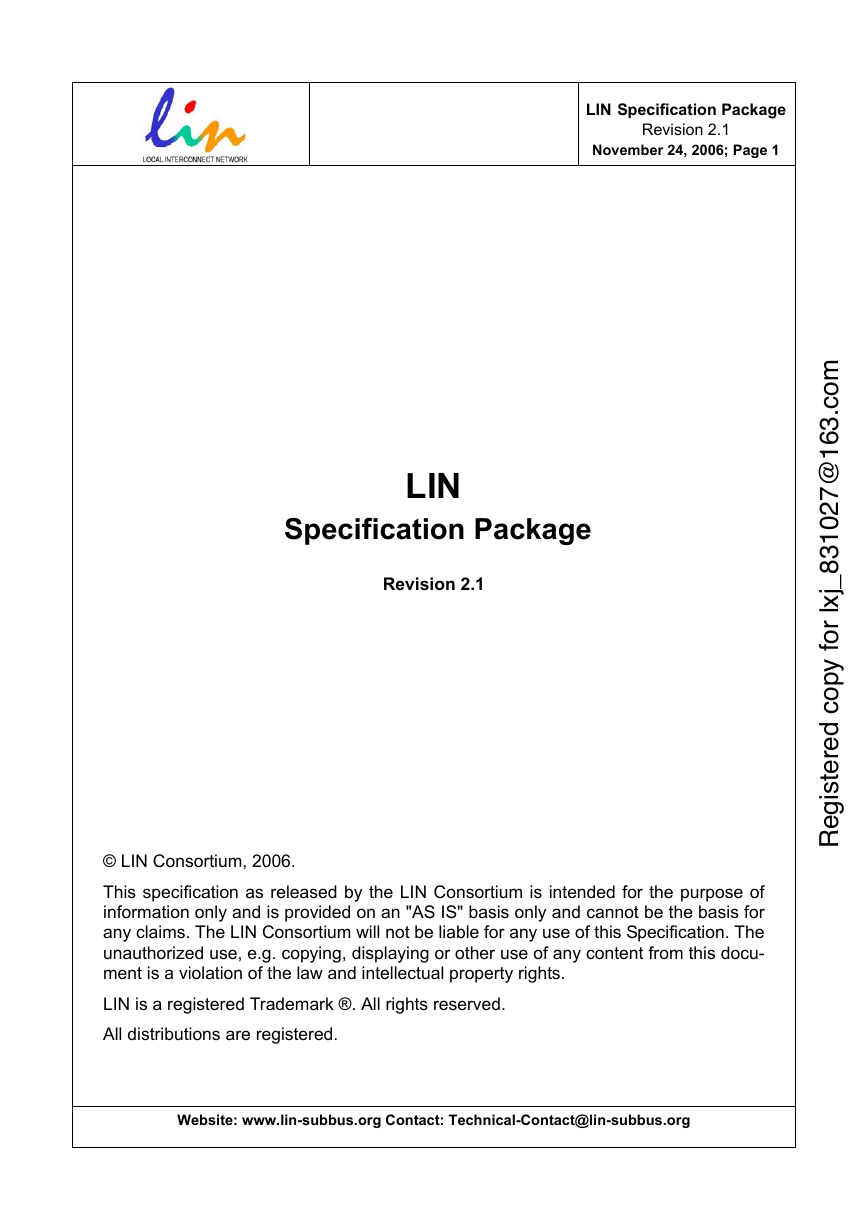
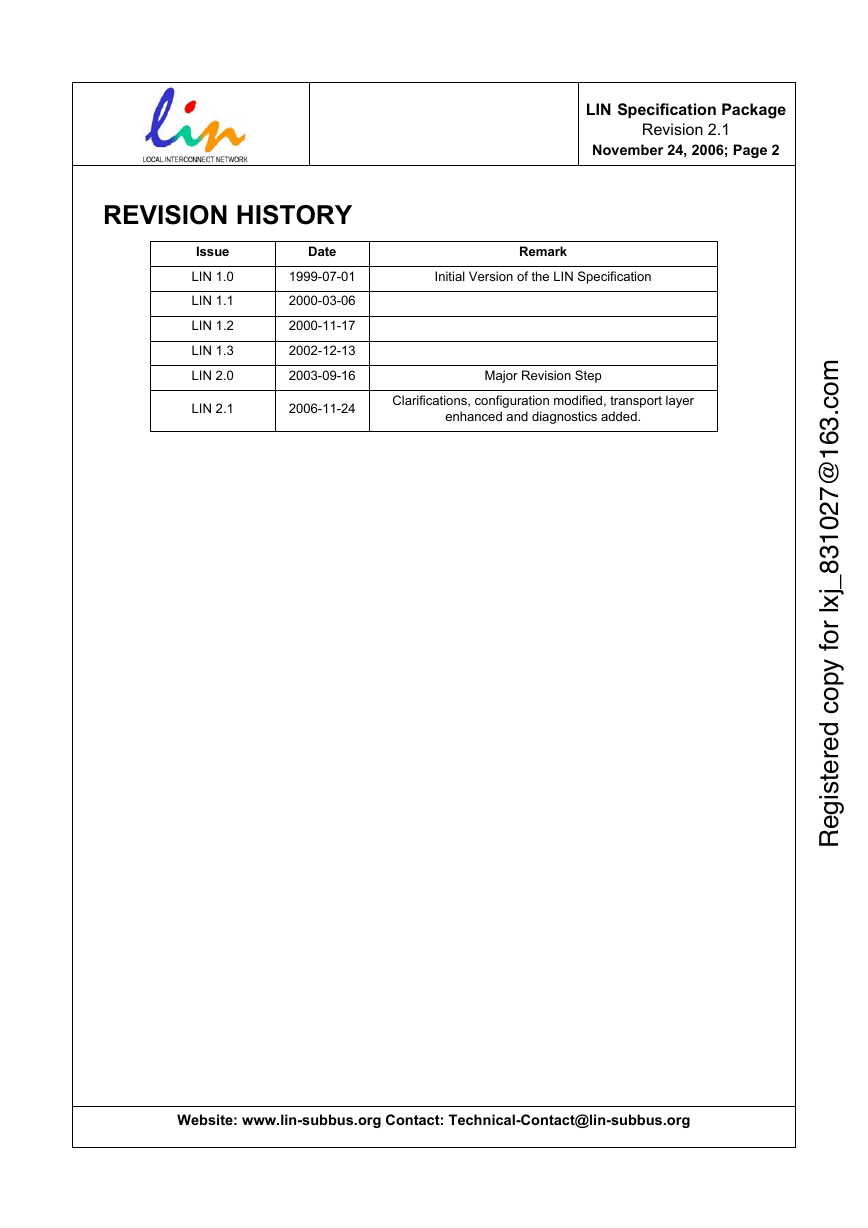


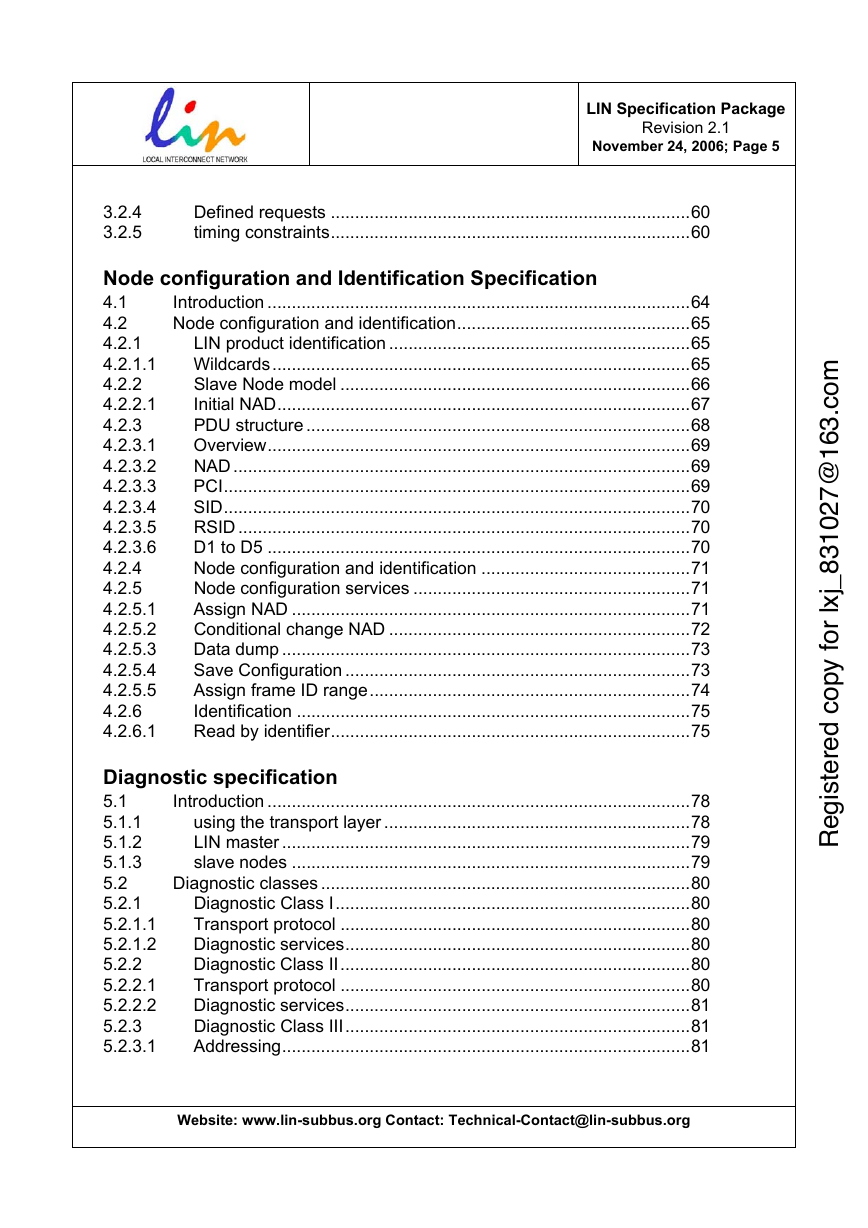
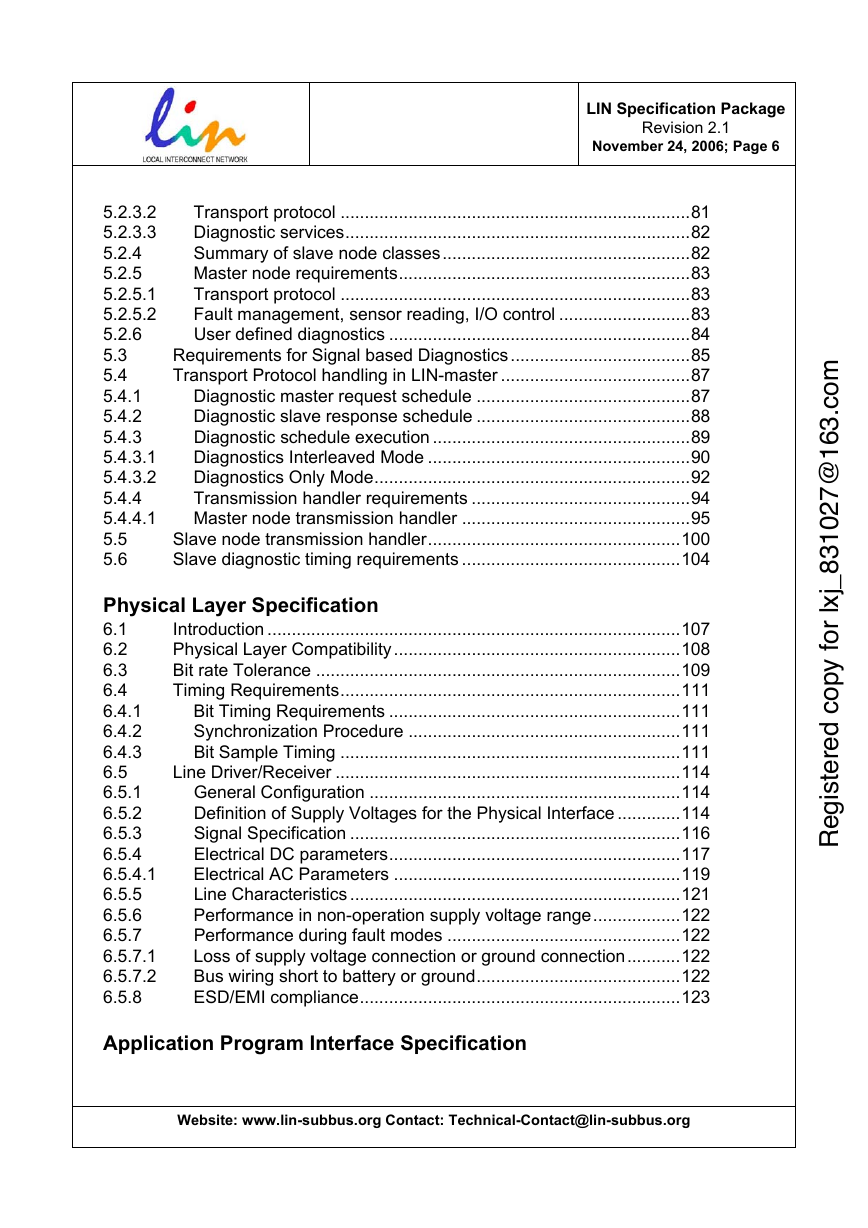
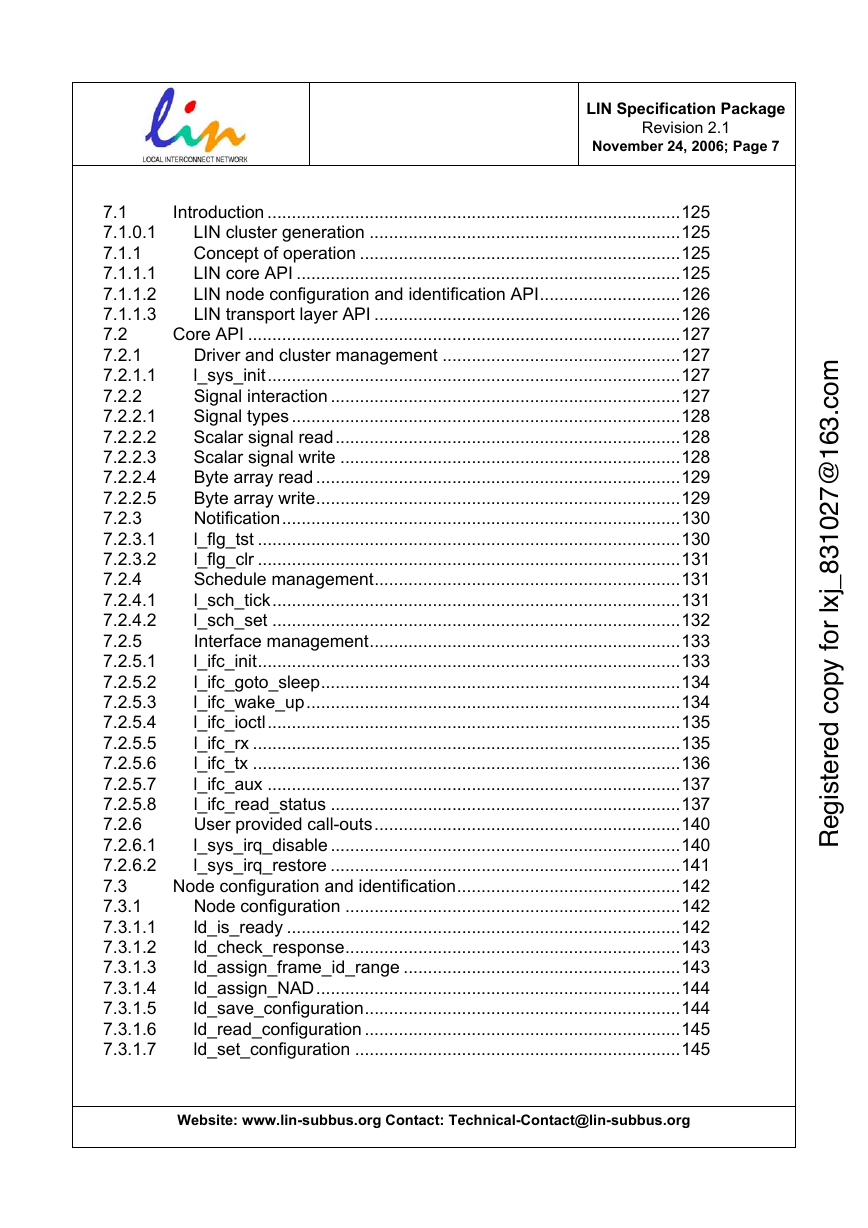
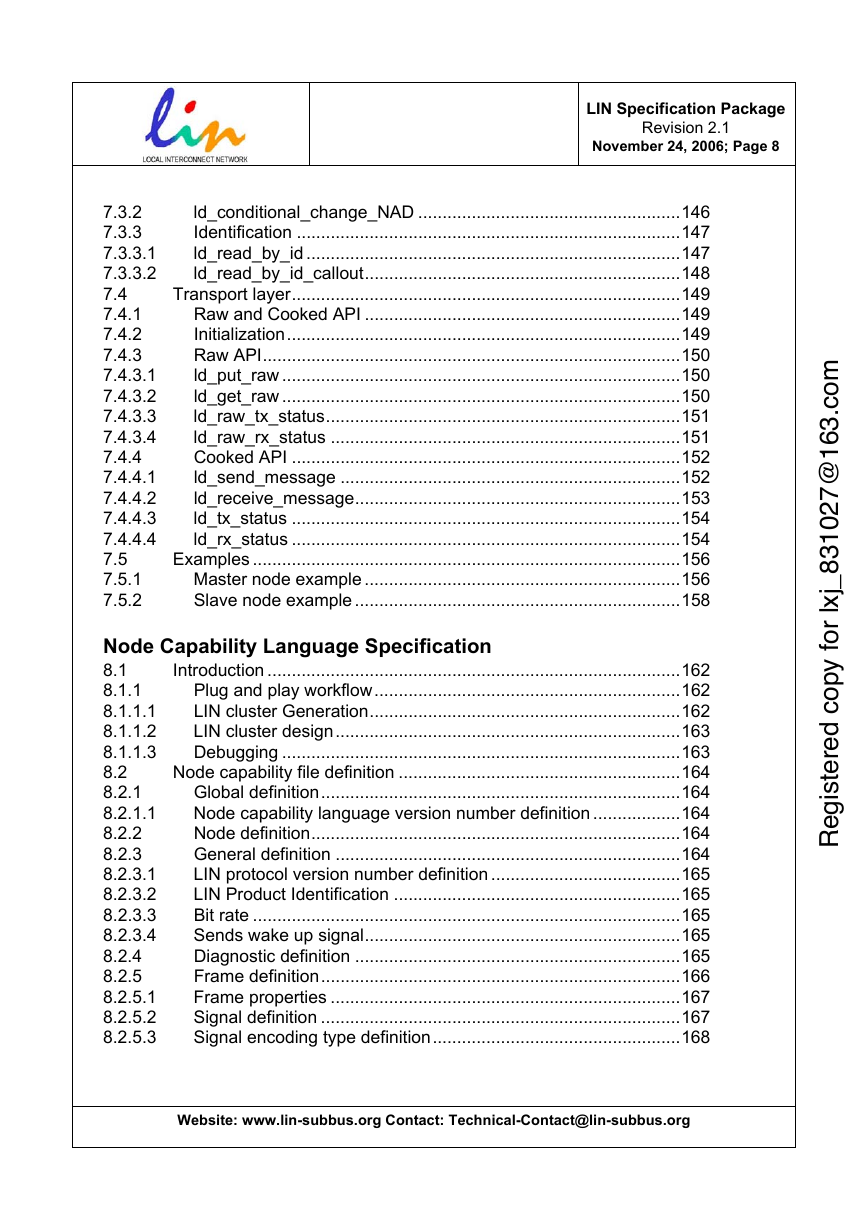








 2023年江西萍乡中考道德与法治真题及答案.doc
2023年江西萍乡中考道德与法治真题及答案.doc 2012年重庆南川中考生物真题及答案.doc
2012年重庆南川中考生物真题及答案.doc 2013年江西师范大学地理学综合及文艺理论基础考研真题.doc
2013年江西师范大学地理学综合及文艺理论基础考研真题.doc 2020年四川甘孜小升初语文真题及答案I卷.doc
2020年四川甘孜小升初语文真题及答案I卷.doc 2020年注册岩土工程师专业基础考试真题及答案.doc
2020年注册岩土工程师专业基础考试真题及答案.doc 2023-2024学年福建省厦门市九年级上学期数学月考试题及答案.doc
2023-2024学年福建省厦门市九年级上学期数学月考试题及答案.doc 2021-2022学年辽宁省沈阳市大东区九年级上学期语文期末试题及答案.doc
2021-2022学年辽宁省沈阳市大东区九年级上学期语文期末试题及答案.doc 2022-2023学年北京东城区初三第一学期物理期末试卷及答案.doc
2022-2023学年北京东城区初三第一学期物理期末试卷及答案.doc 2018上半年江西教师资格初中地理学科知识与教学能力真题及答案.doc
2018上半年江西教师资格初中地理学科知识与教学能力真题及答案.doc 2012年河北国家公务员申论考试真题及答案-省级.doc
2012年河北国家公务员申论考试真题及答案-省级.doc 2020-2021学年江苏省扬州市江都区邵樊片九年级上学期数学第一次质量检测试题及答案.doc
2020-2021学年江苏省扬州市江都区邵樊片九年级上学期数学第一次质量检测试题及答案.doc 2022下半年黑龙江教师资格证中学综合素质真题及答案.doc
2022下半年黑龙江教师资格证中学综合素质真题及答案.doc